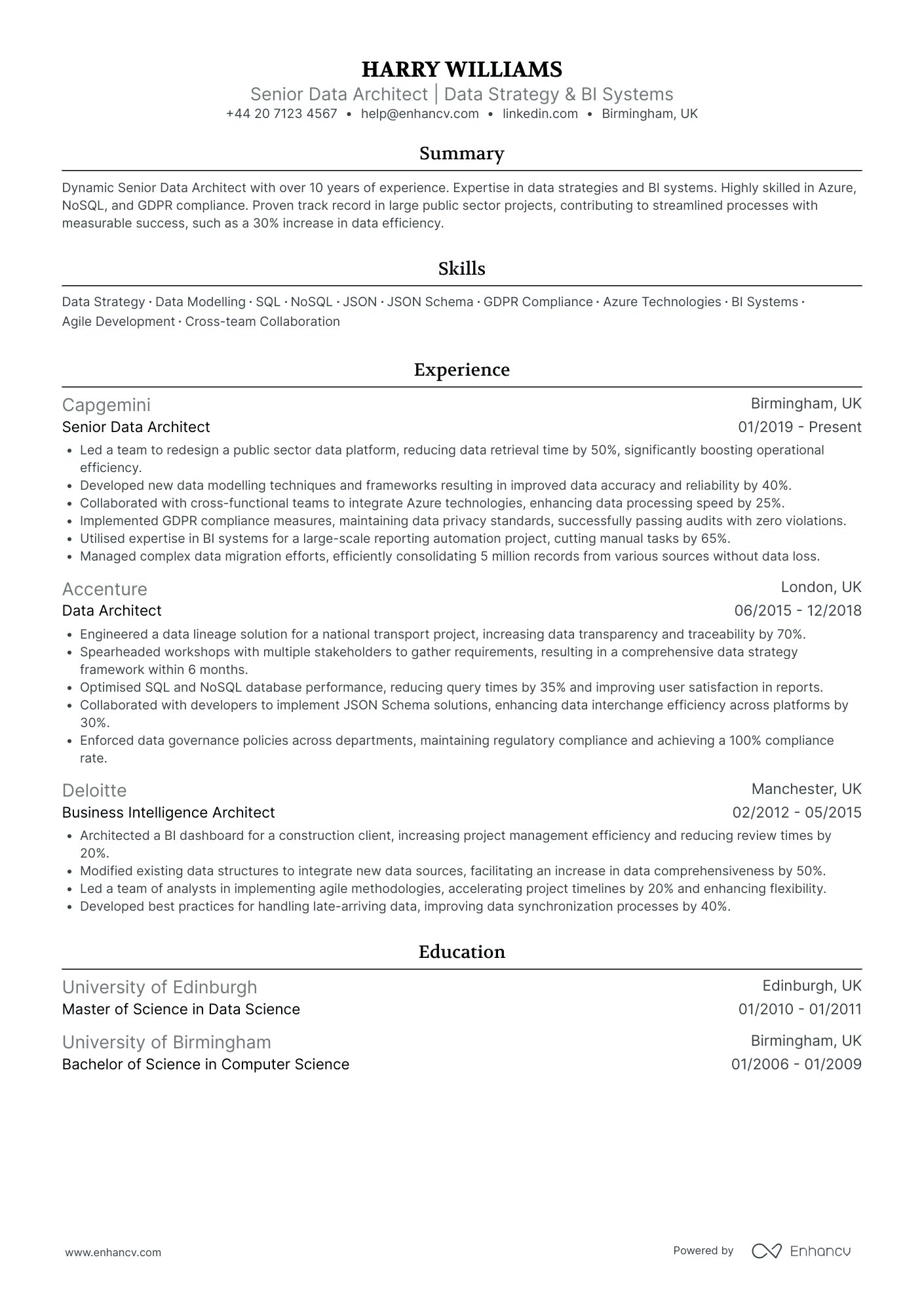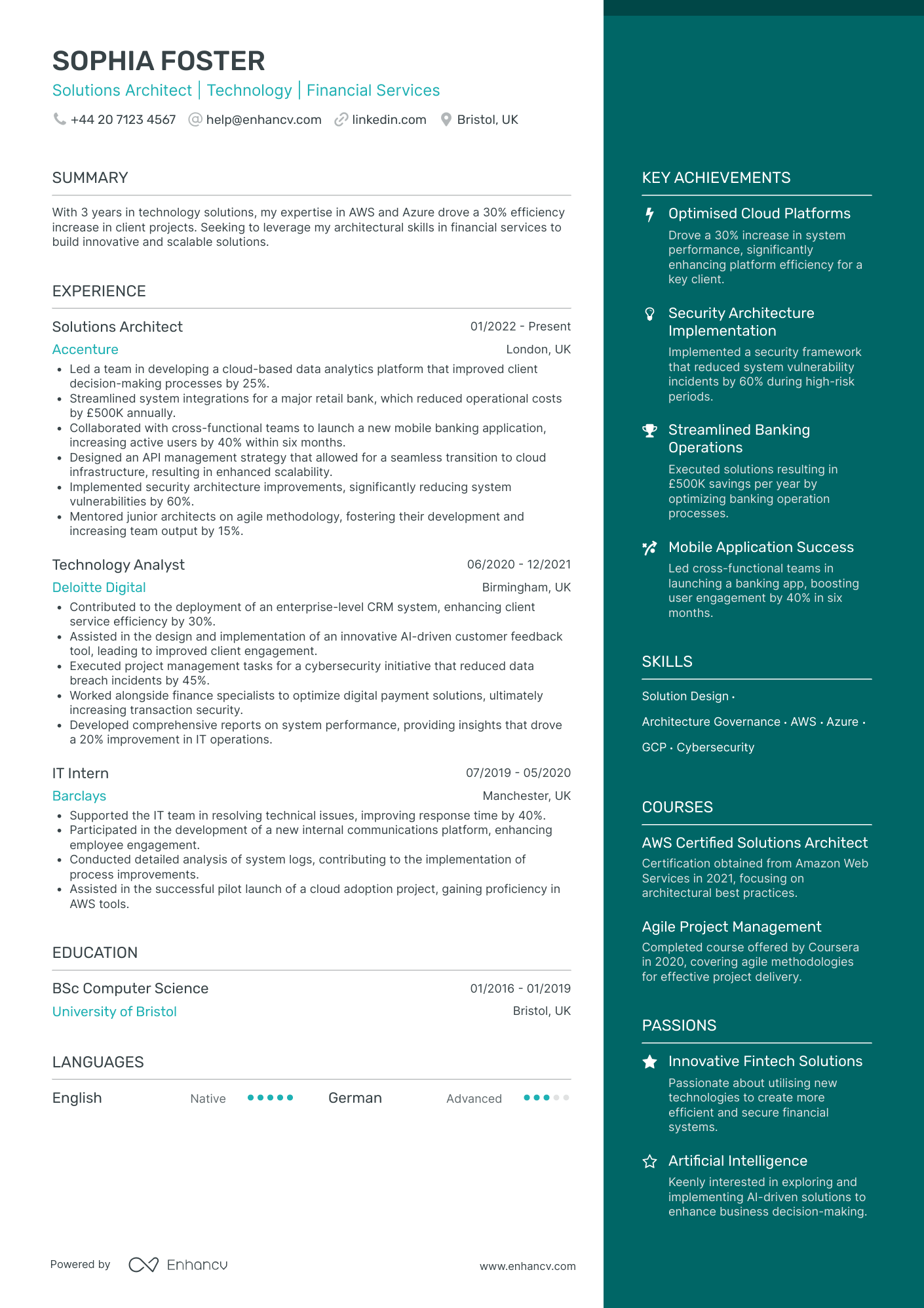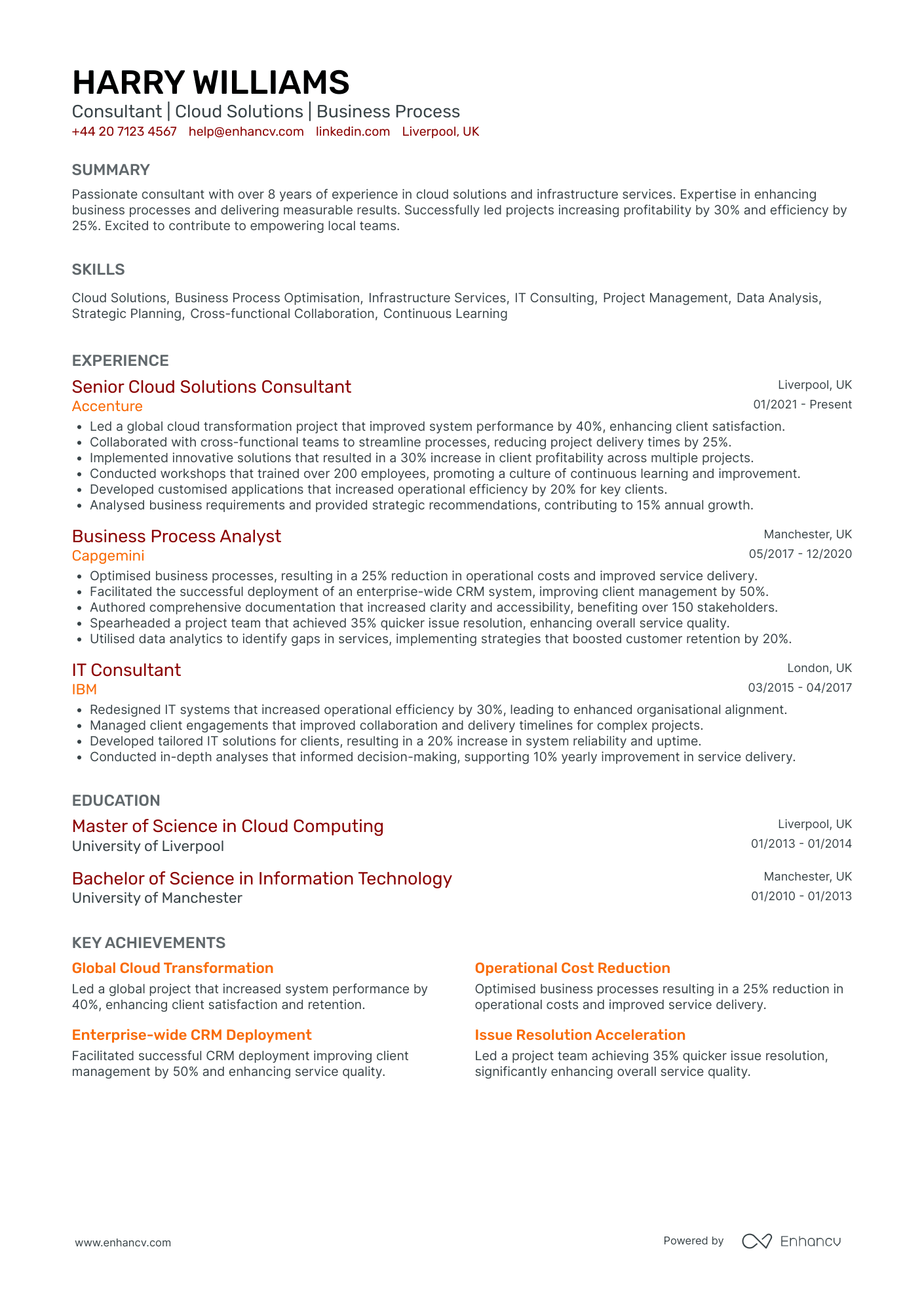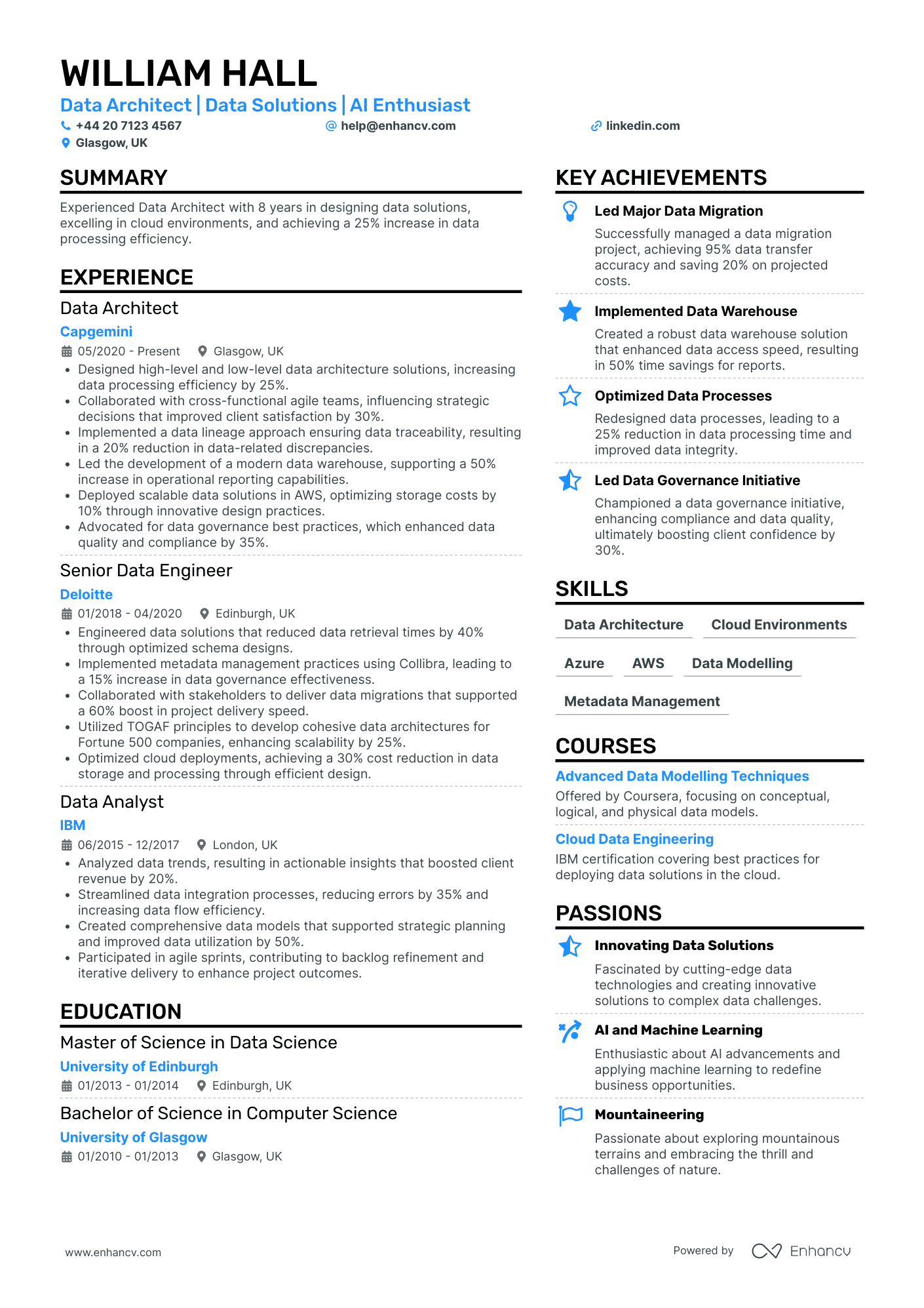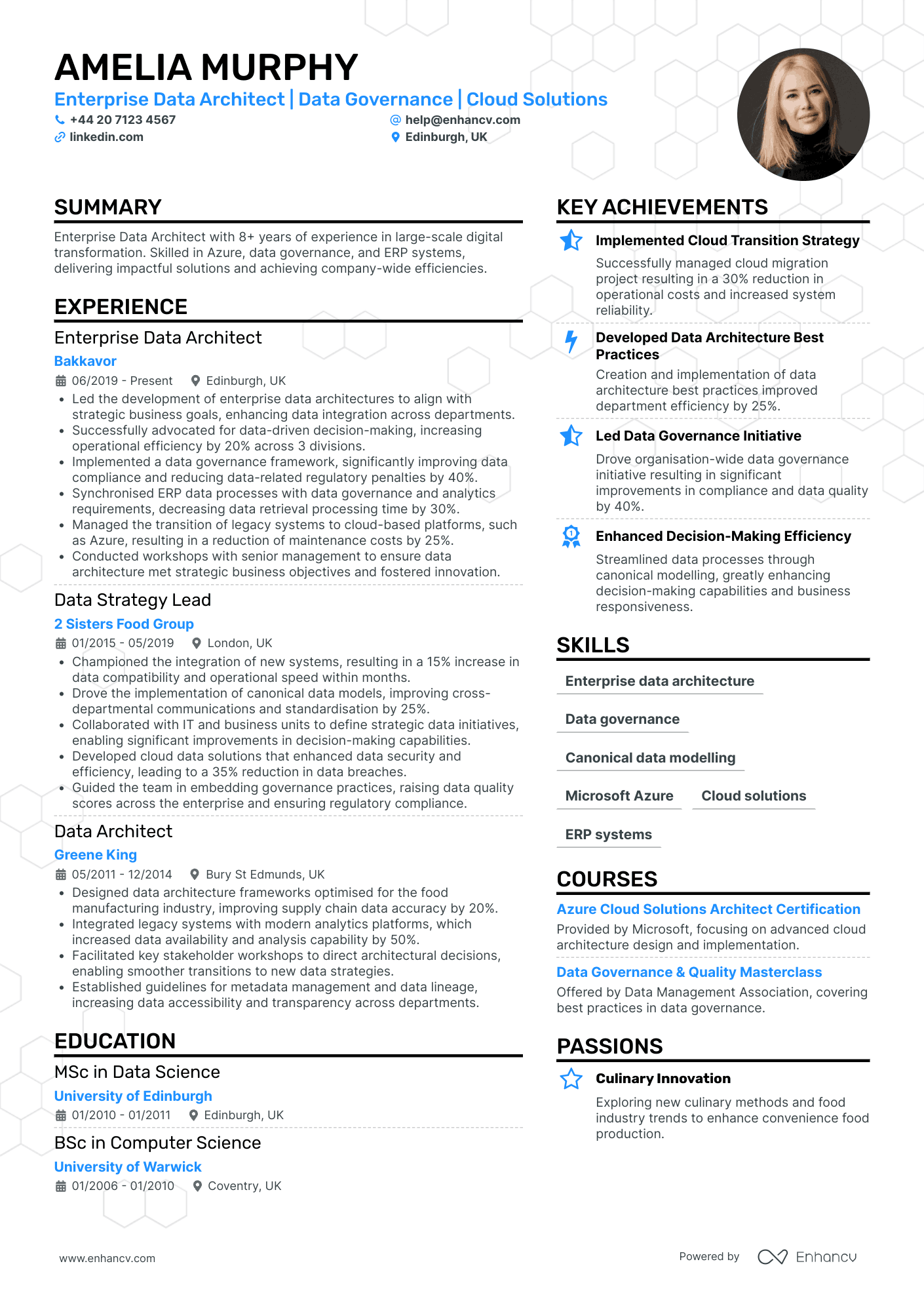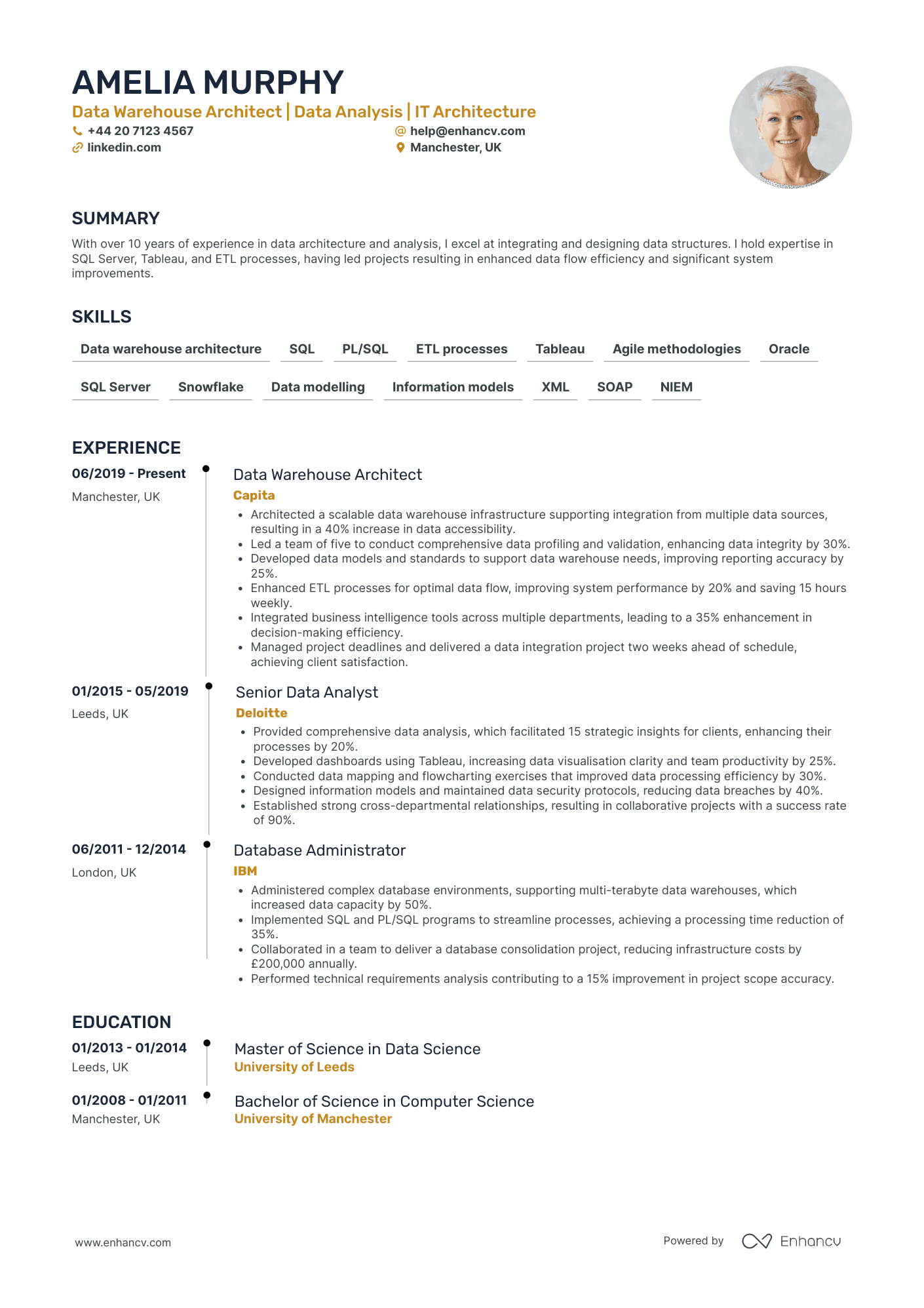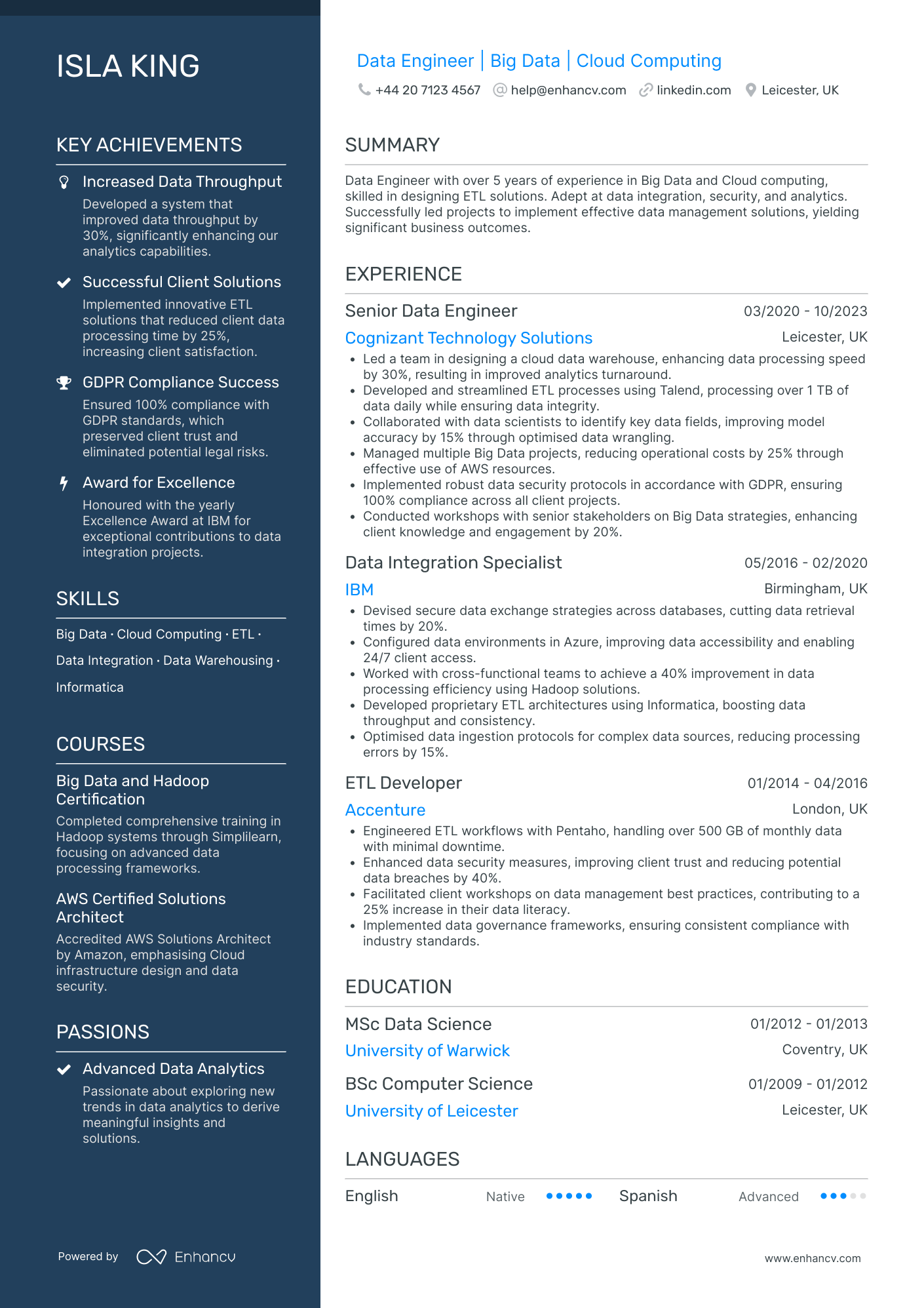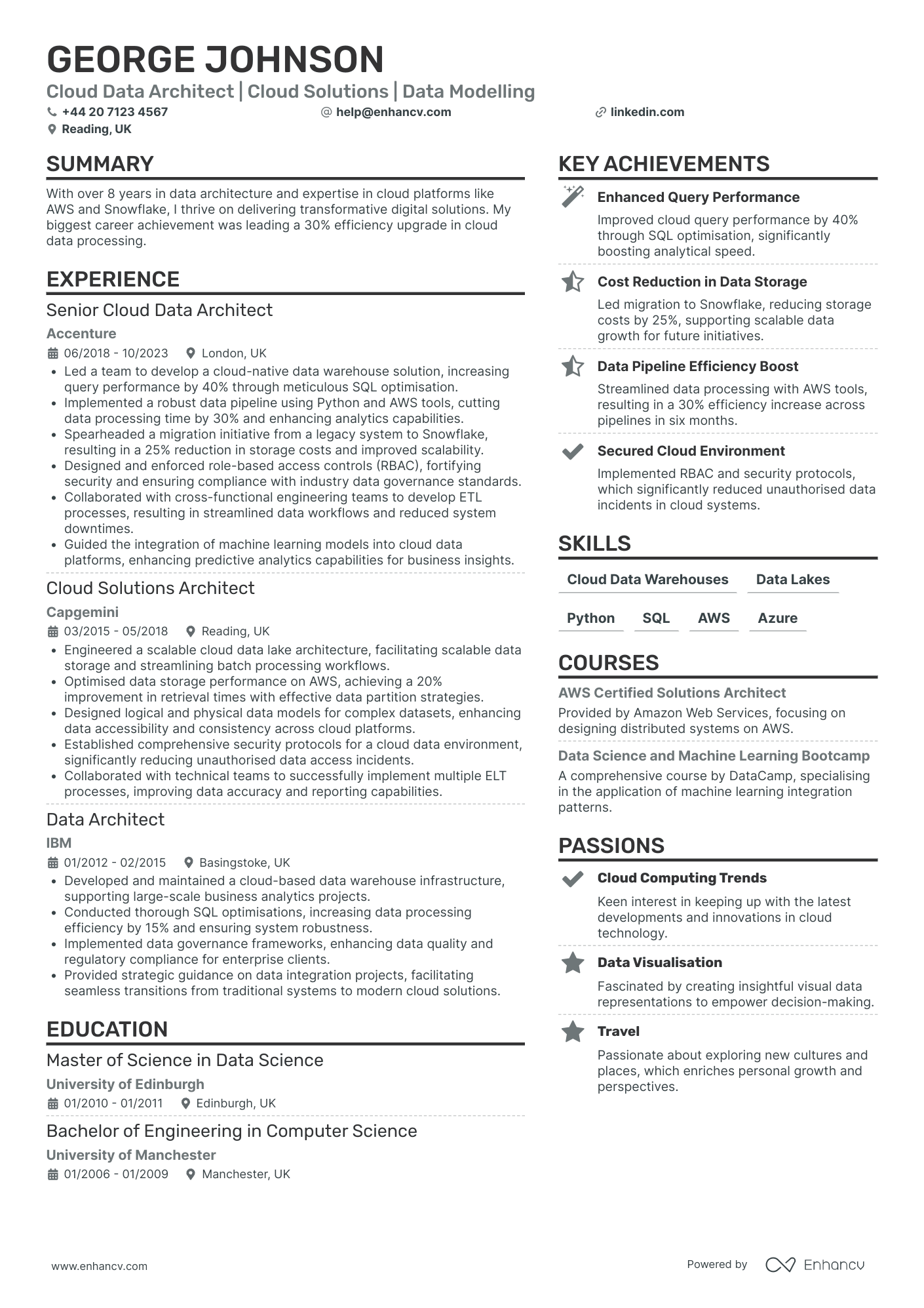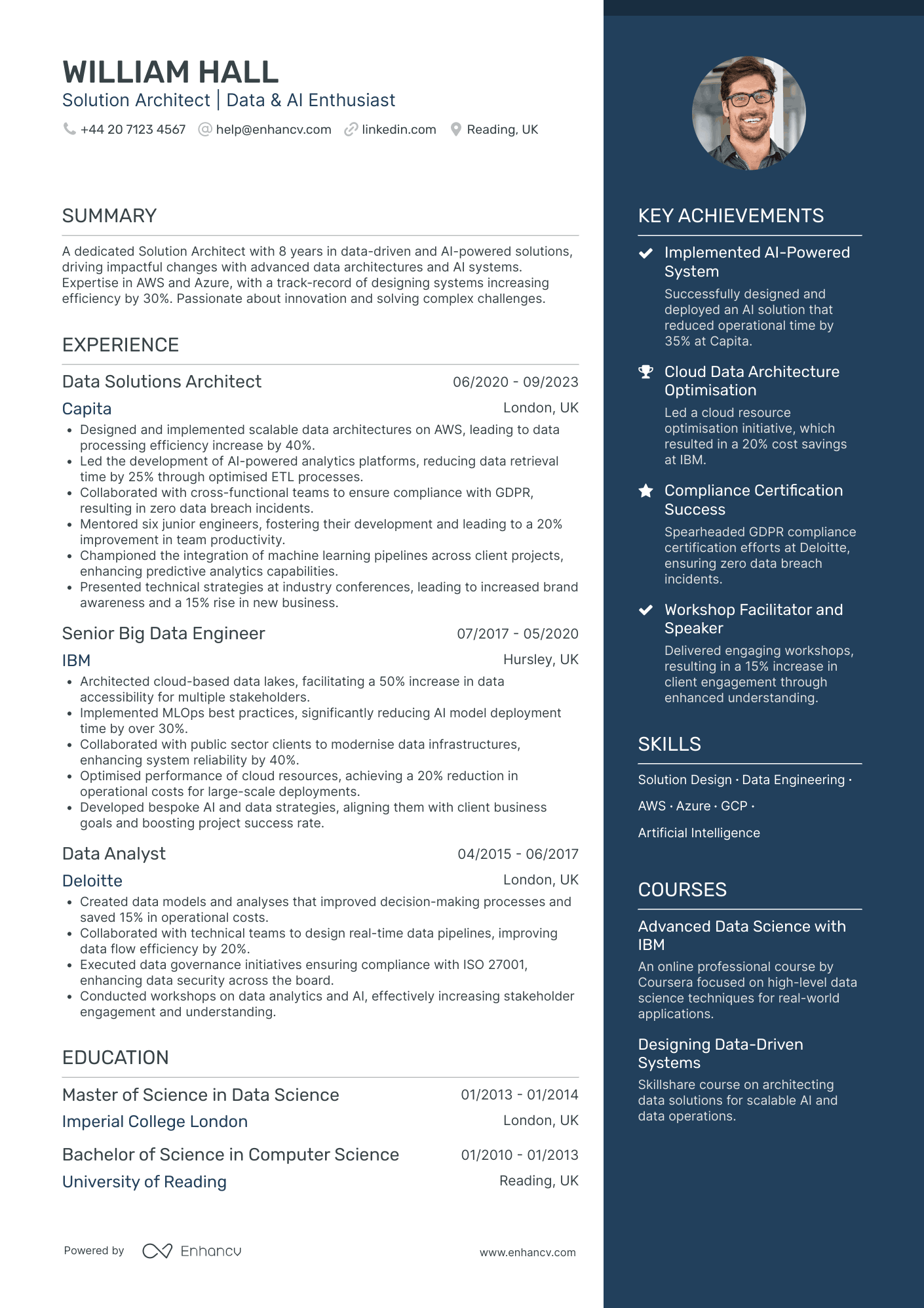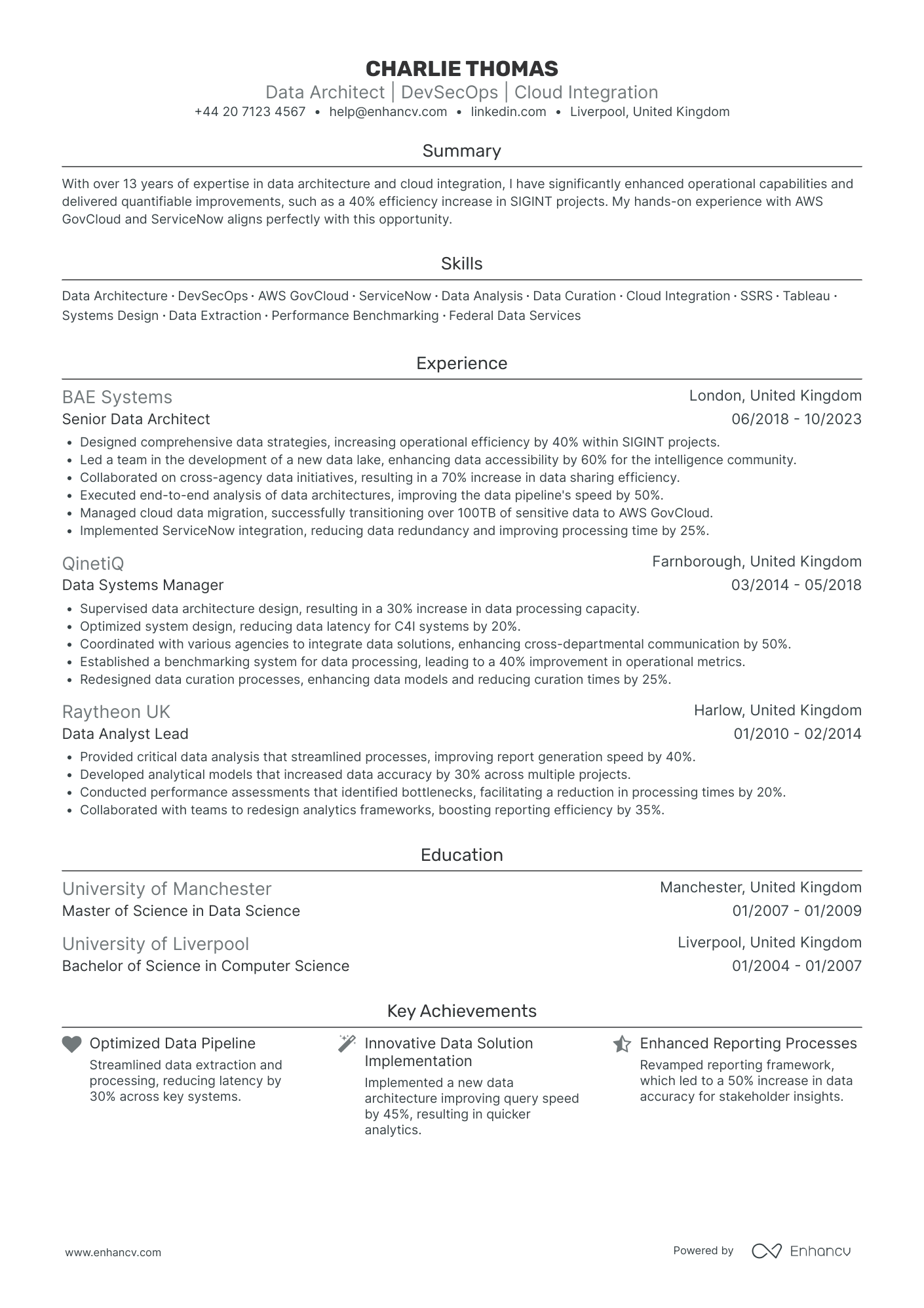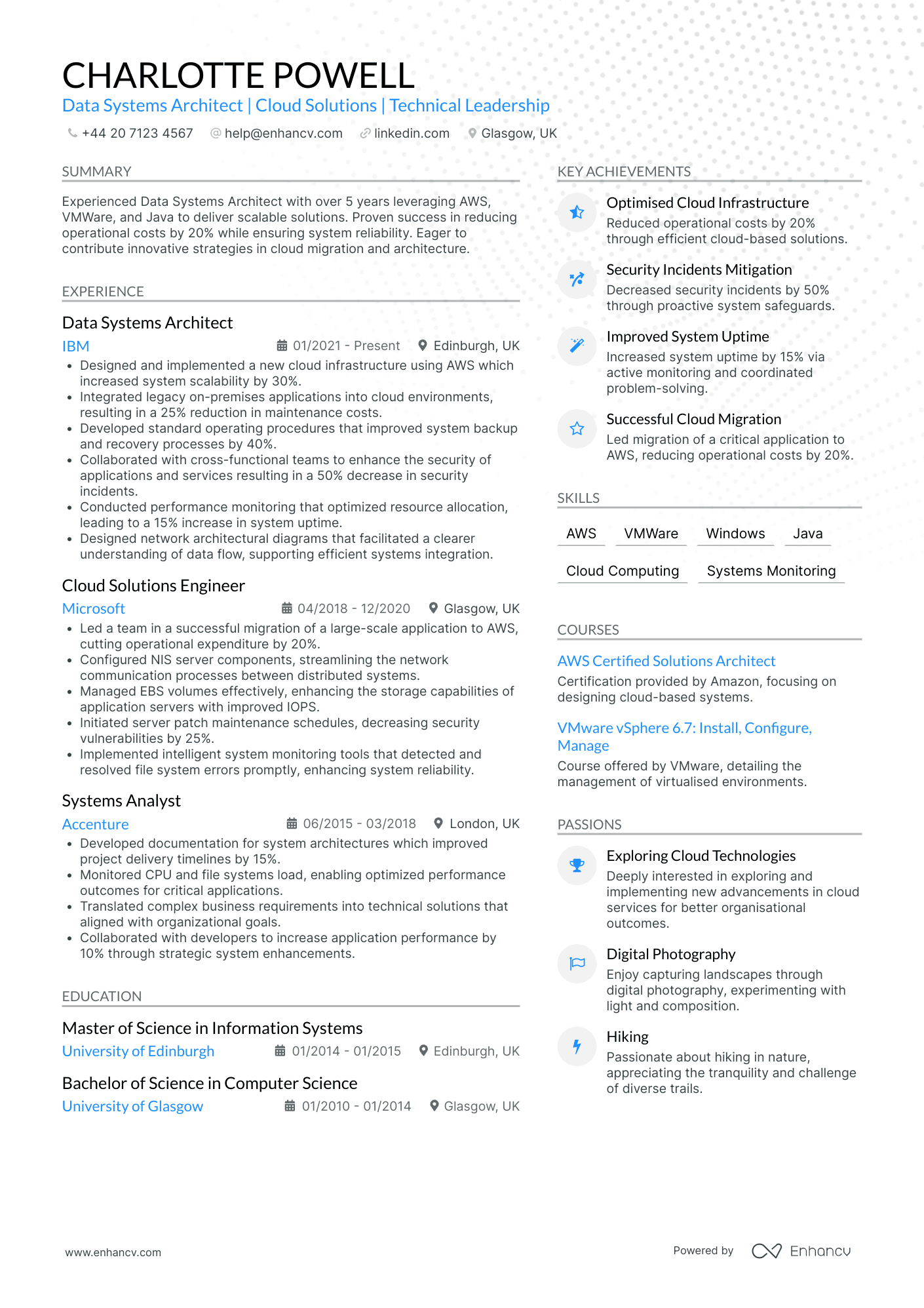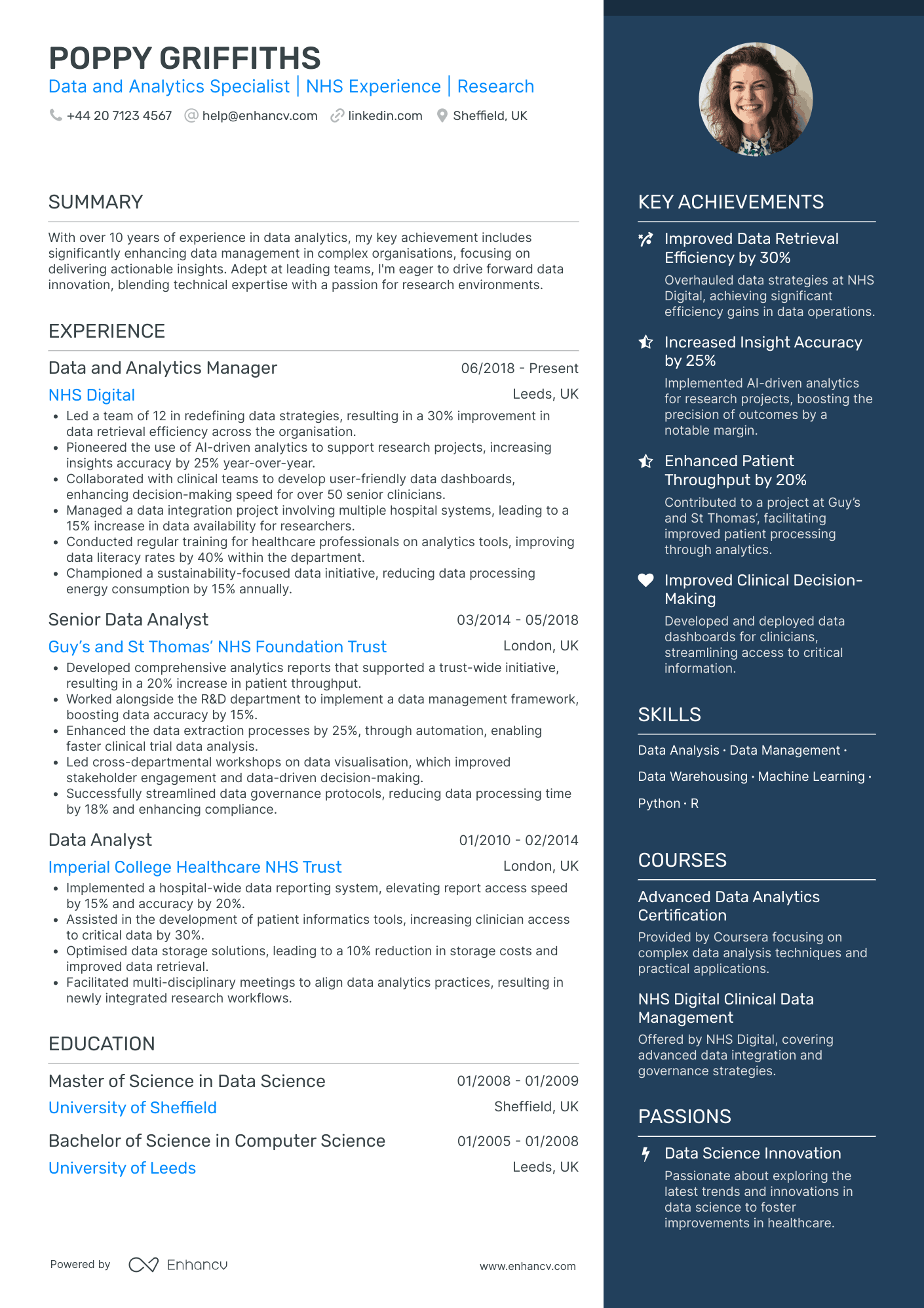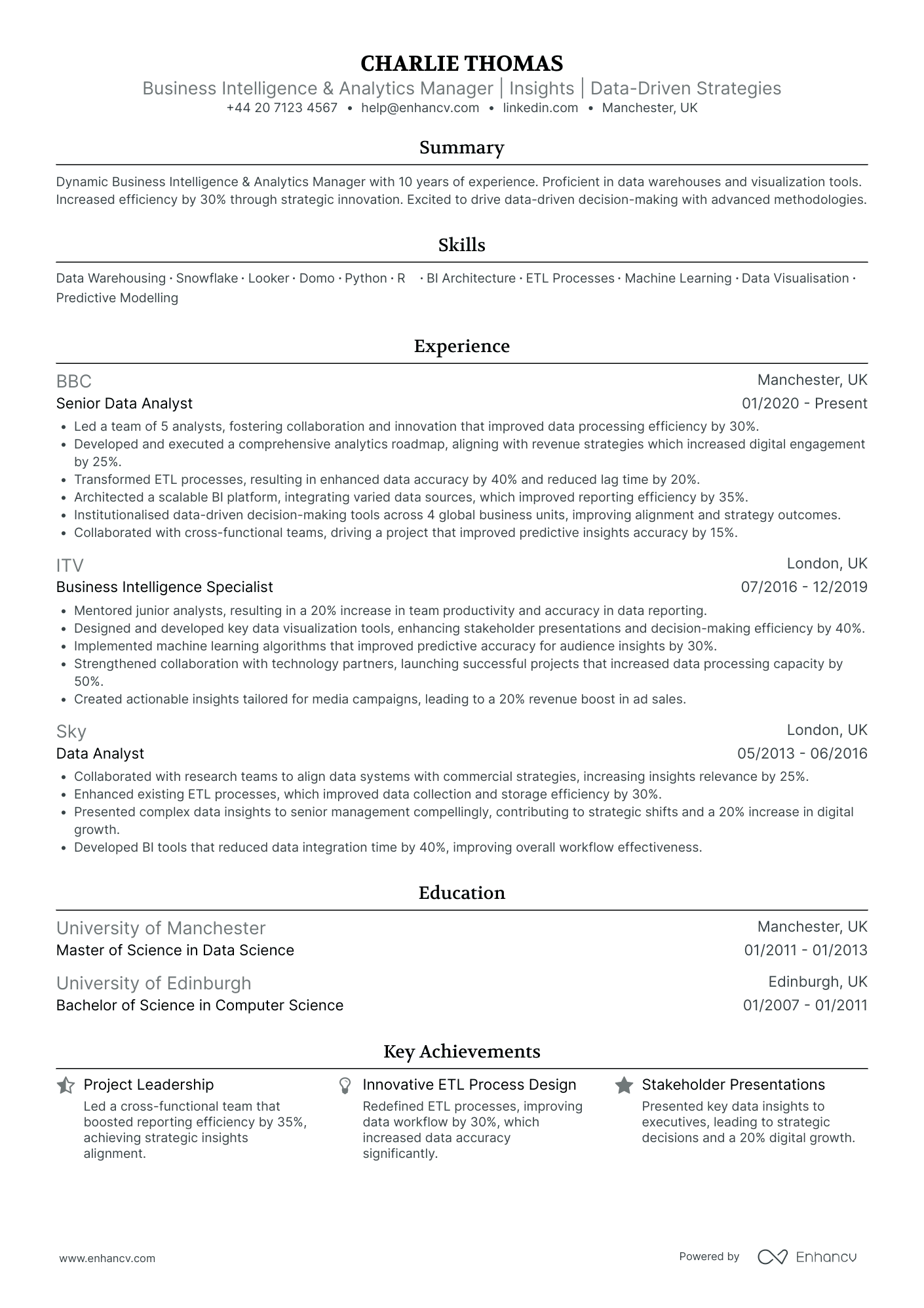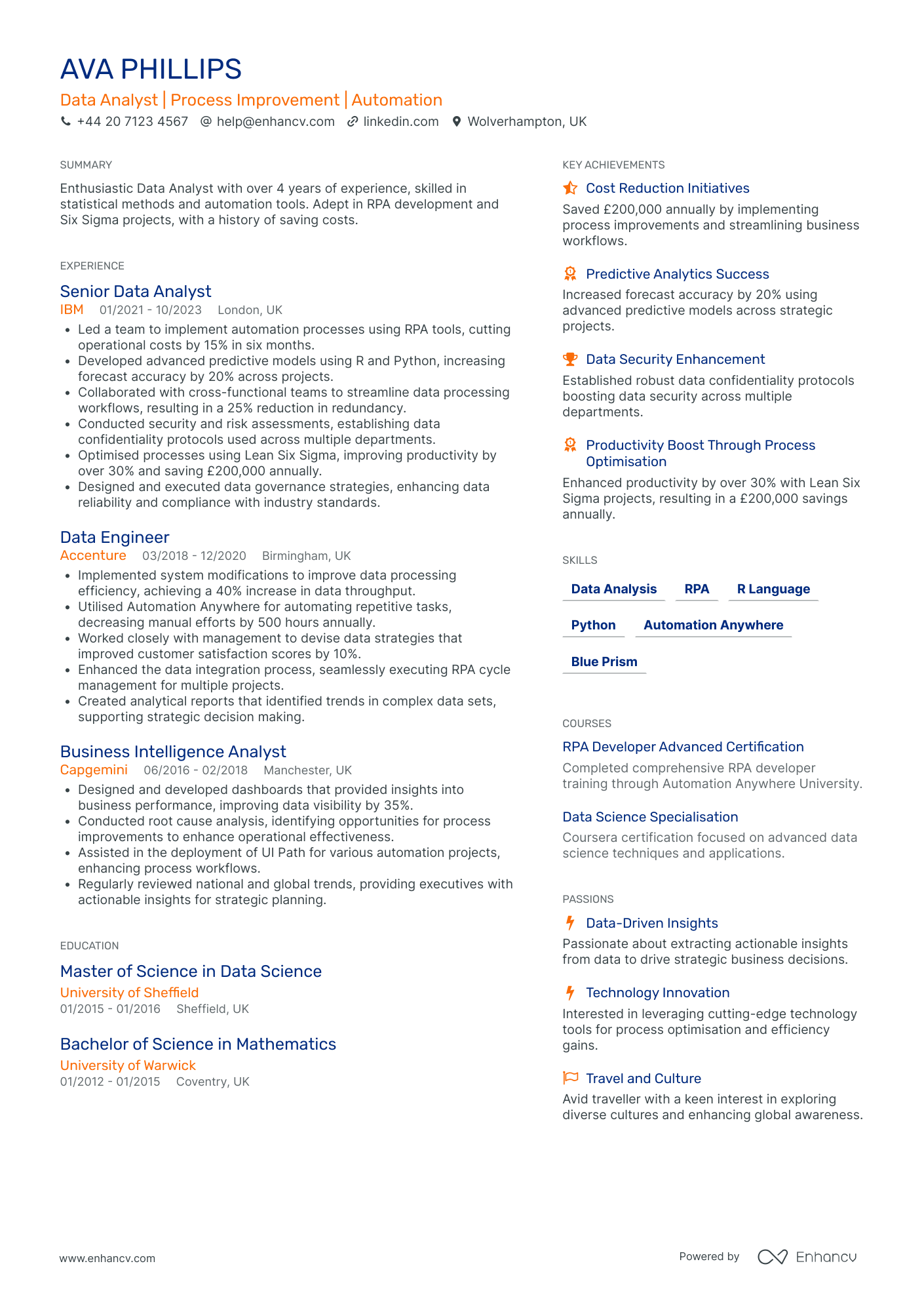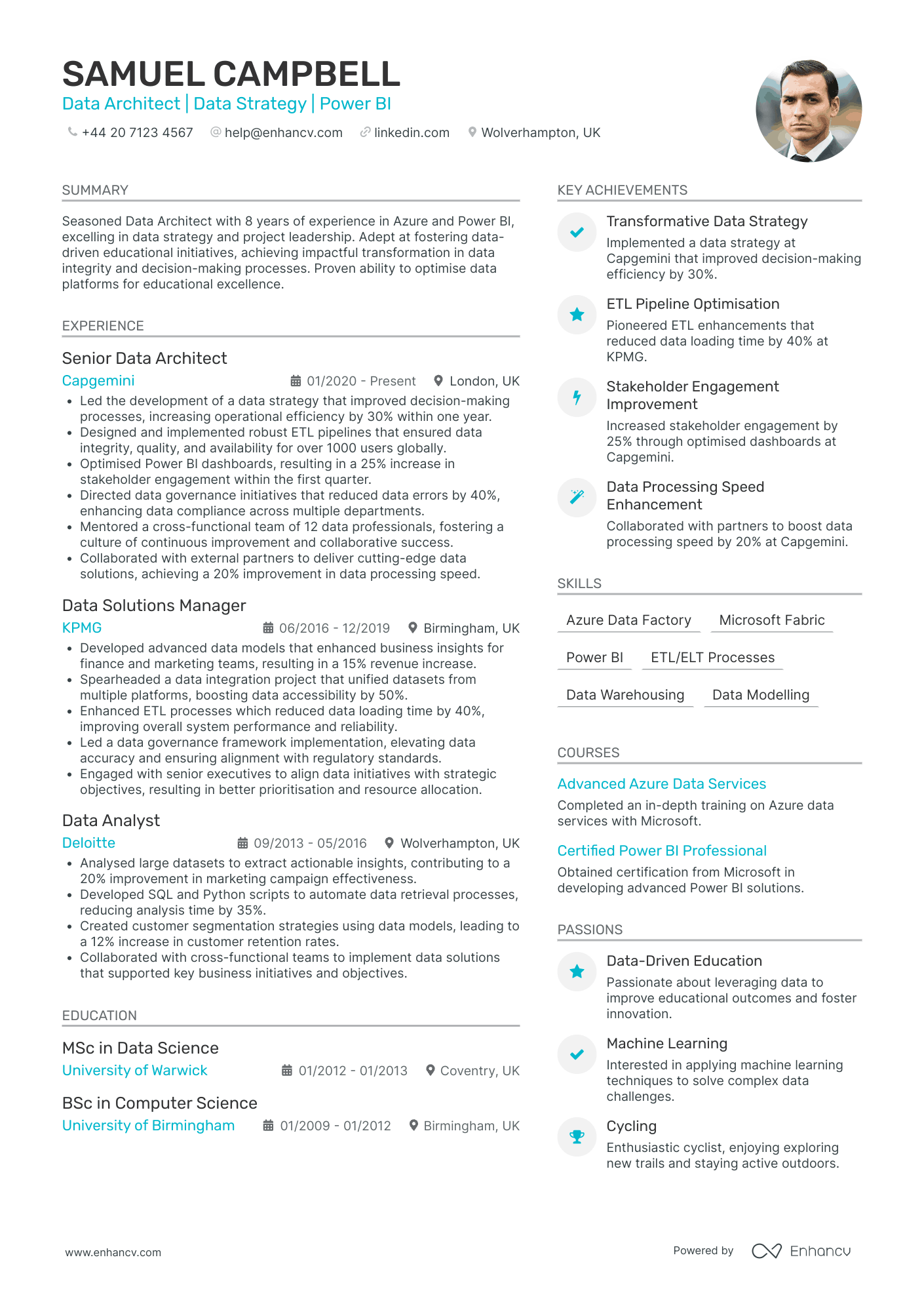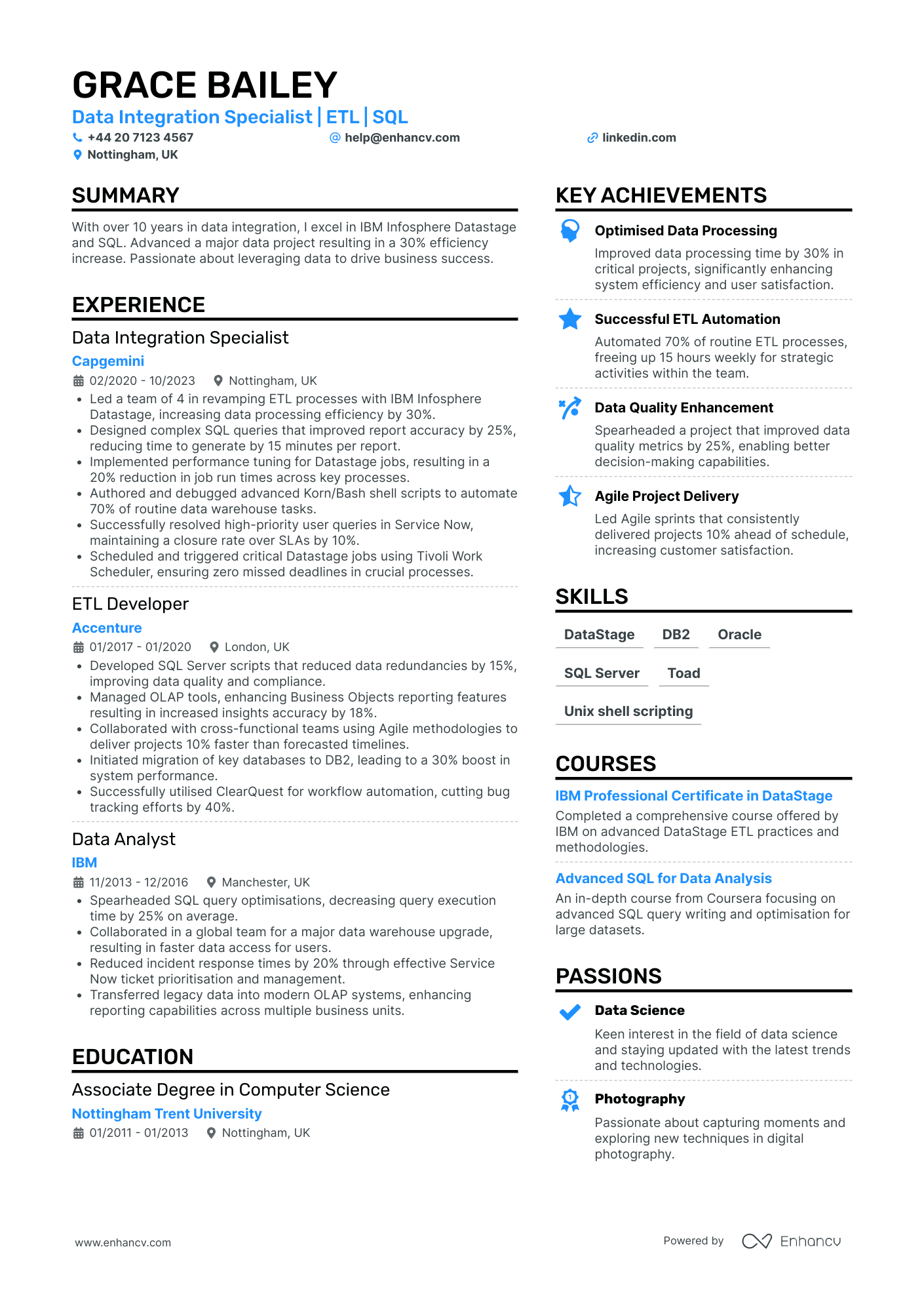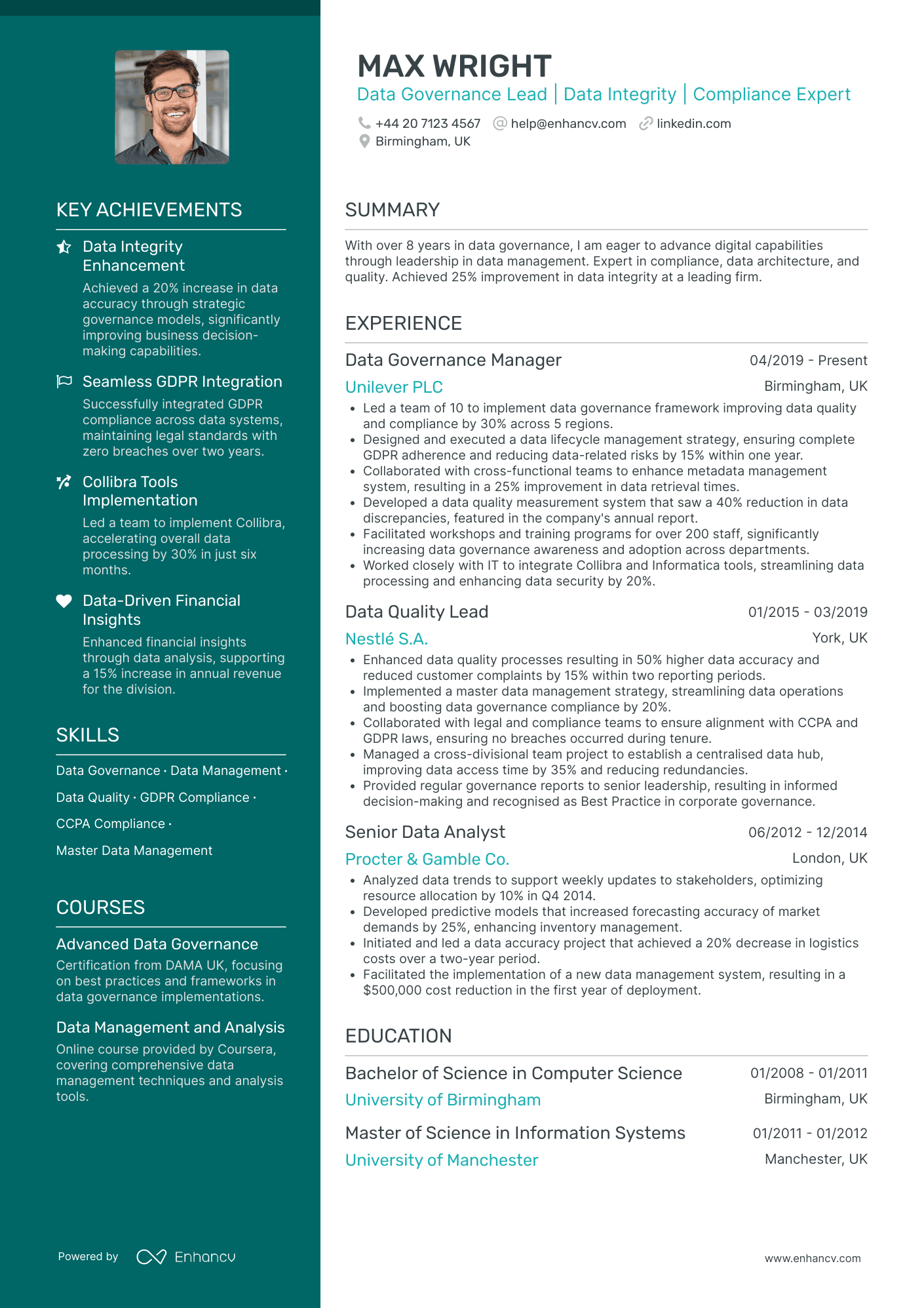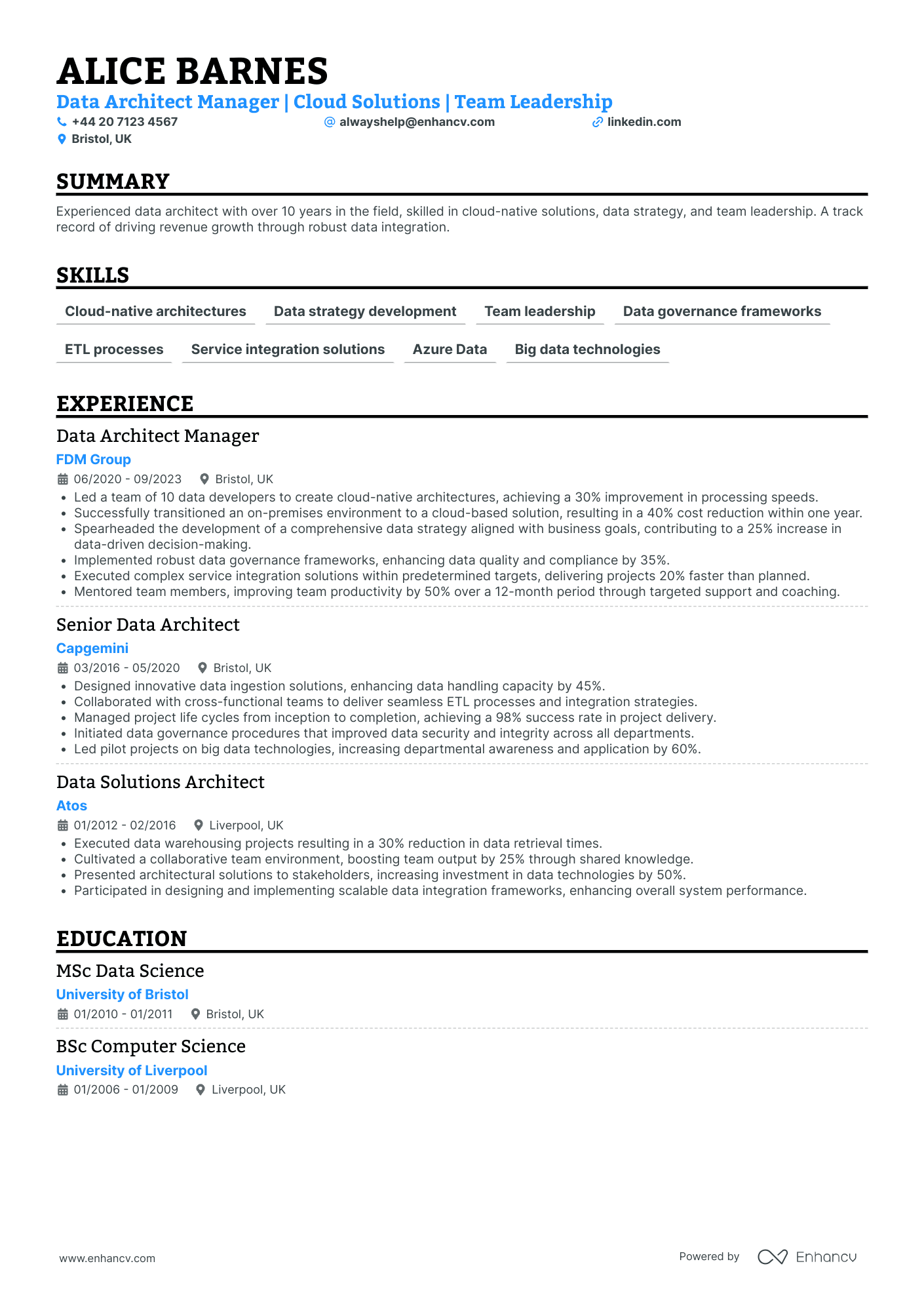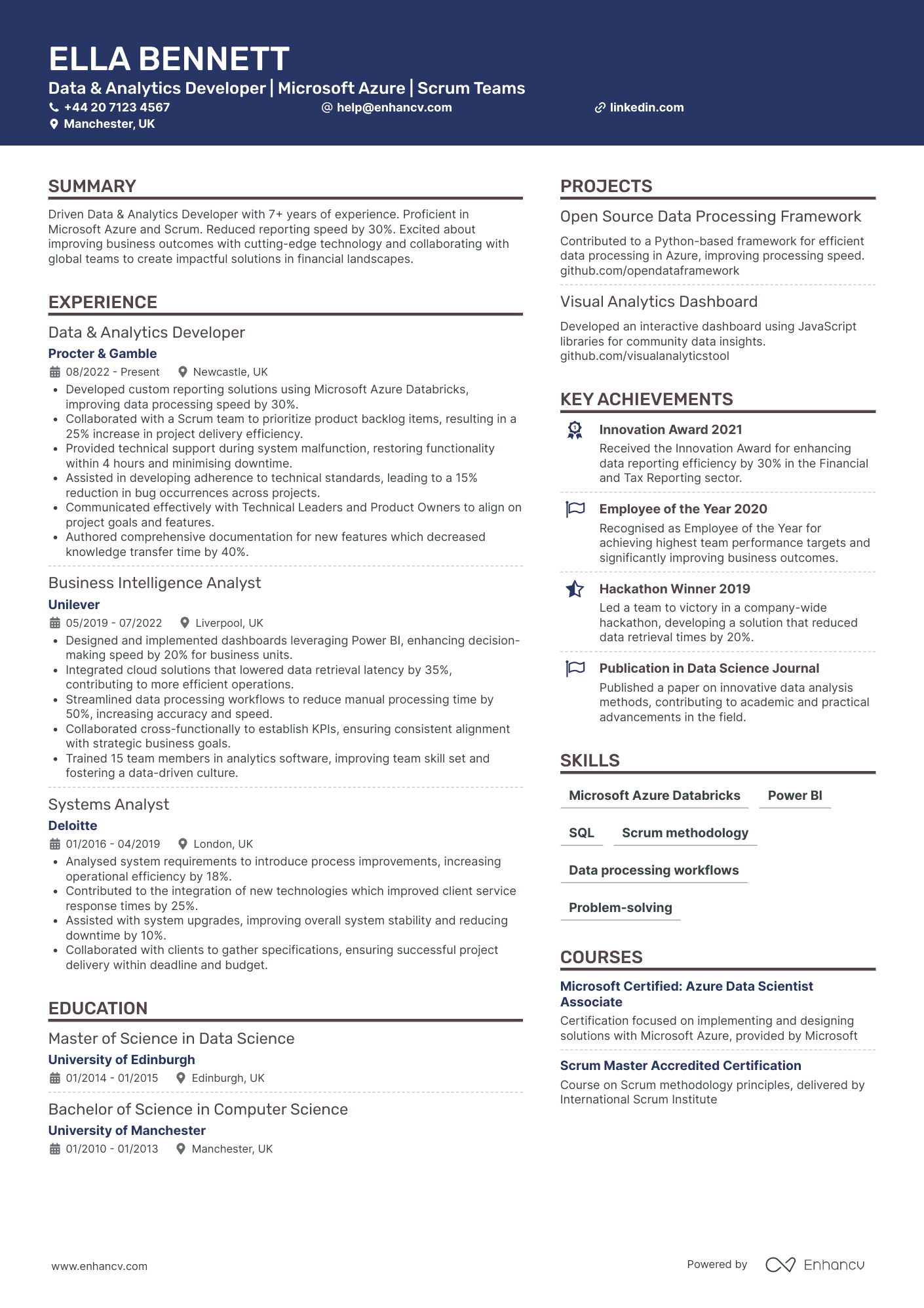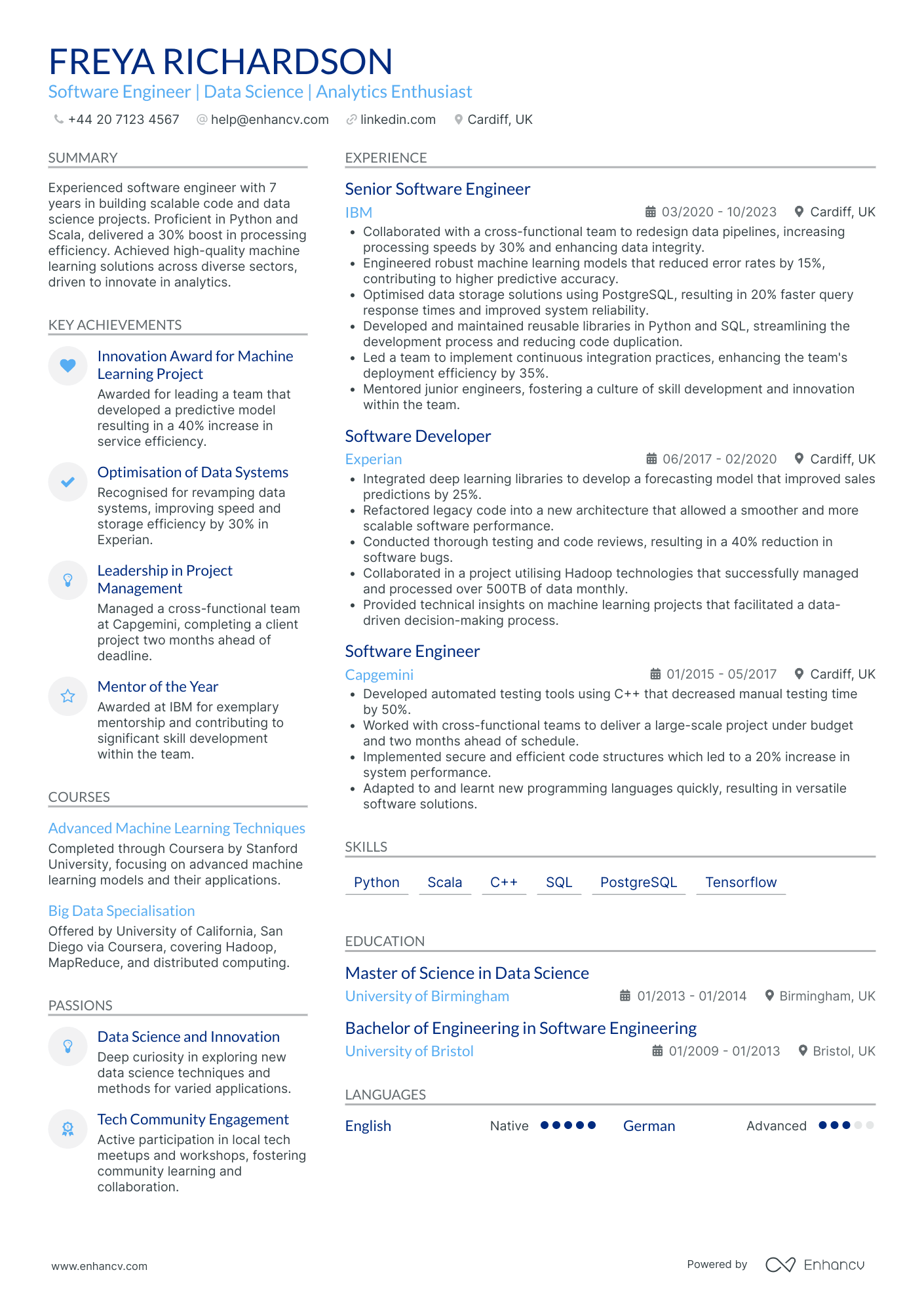Crafting a CV that effectively showcases the depth of your technical expertise and project management skills can be a daunting challenge as a data architect. Fortunately, our guide provides tailored strategies to help you highlight your most impressive accomplishments and convey the complexity of your role clearly and succinctly.
- Applying best practices from real-world examples to ensure your profile always meets recruiters' expectations;
- What to include in your work experience section, apart from your past roles and responsibilities?
- Why are both hard and soft skills important for your application?
- How do you need to format your CV to pass the Applicant Tracker Software (ATS) assessment?
If you're writing your CV for a niche data architect role, make sure to get some inspiration from professionals:
Resume examples for data architect
By Experience
Senior Data Architect
- Clear and Impactful Presentation - The CV is well-structured, providing a clear and concise presentation of the candidate's credentials. Each section is logically ordered, beginning with a strong summary that effectively encapsulates the applicant's expertise in data architecture and BI systems. This structured approach ensures readability and allows potential employers to quickly grasp key qualifications and achievements.
- Consistent Career Growth and Diverse Experiences - Harry Williams' career trajectory demonstrates steady growth, with strategic moves from Business Intelligence Architect at Deloitte to Data Architect at Accenture, and finally, Senior Data Architect at Capgemini. This progression reflects a rising arc in responsibility and expertise, showcasing the candidate's ability to adapt to different roles within high-profile consultancy firms while elevating their stature in data strategy.
- Strategic Use of Industry Tools and Methodologies - The CV highlights extensive expertise in Azure technologies, NoSQL, and BI systems, underscoring the candidate's technical depth. The use of advanced tools and methodologies, such as GDPR compliance and innovative data modelling techniques, signifies a forward-thinking approach that aligns with industry trends and organizational needs, making the candidate a valuable asset in data-intensive environments.
Junior Data Architect
- Impressive Career Growth - The CV showcases Sophia Foster’s rapid advancement from an IT Intern to a Solutions Architect within a few years. Her trajectory displays a significant build-up of expertise and responsibility in different roles, painting a picture of a professional who is capable of scaling quickly within the technology and financial services sectors.
- Achievement-Driven Impact - Each experience section is bolstered by concrete accomplishments that illustrate business impact, from reducing operational costs by £500K to improving client decision-making by 25%. These achievements are more than just numbers; they underline Sophia’s ability to deliver substantial, quantifiable improvements in efficiency and performance.
- Diverse Technical Skillset - Sophia's CV effectively underscores her mastery of key industry tools and methodologies, such as AWS, Azure, cloud-based analytics, and cybersecurity innovations. This technical depth is complemented by her certification as an AWS Certified Solutions Architect, demonstrating her capability to design scalable and secure technology solutions specific to the financial industry.
Lead Data Architect
- Clear and Structured Presentation - The CV is organized with clarity, presenting each section in a concise manner. Sections such as experience, education, and skills are easy to navigate, allowing readers to quickly understand the candidate’s qualifications and career achievements.
- Career Trajectory Illustrates Strong Growth - Harry's career path exemplifies upward movement and development, showing progression from an IT Consultant to a Senior Cloud Solutions Consultant. This not only highlights professional growth but also demonstrates a deepening expertise in cloud solutions and business process optimization within different leading companies.
- Methodologies and Technical Expertise in Cloud Solutions - A notable strength of this CV is Harry's technical depth in cloud computing and process optimization, conveyed through specific projects and certifications such as the Lean Six Sigma Green Belt. His accomplishments, like leading global transformation projects and deploying enterprise-wide CRM systems, underscore his strategic impact in the technology sector.
Principal Data Architect
- Concise and Strategic Presentation - The CV stands out in its clear, structured, and concise manner, efficiently presenting William Hall’s background. Each section is precisely outlined, focusing on relevant information like experience, skills, and achievements which are directly applicable to his role as a Data Architect. The bullet-point format aids in clarity and ease of reading.
- Impressive Career Progression - William's career trajectory exhibits significant growth and a focus on increasing responsibilities, transitioning from a Data Analyst to a Senior Data Engineer and eventually to a Data Architect. This progression reflects his capability to adapt and thrive in complex environments, which is essential for delivering robust data solutions.
- Emphasis on Adaptability and Cross-Functional Collaboration - The CV highlights William’s extensive experience working in cross-functional and agile teams. His achievements in improving client satisfaction and enhancing data governance underscore his ability to adapt and interface with various teams and stakeholders, driving strategic decisions that lead to business success.
By Role
Enterprise Data Architect
- Clear structure and comprehensive details - The CV is well-organized, with distinct sections for skills, experience, education, and achievements. Each employment entry includes concise bullet points that clearly outline responsibilities and outcomes, making it easy to identify key strengths and contributions.
- Progressive career development - Amelia's career trajectory reflects significant growth, moving from a Data Architect at Greene King to an Enterprise Data Architect at Bakkavor, showcasing her advancement in responsibility and expertise. Her transition from data strategy to architecture highlights her adaptability and expanding industry influence.
- Demonstrated technical expertise and industry methodologies - The CV features a strong focus on technical tools and methodologies, such as Microsoft Azure, ERP systems, and canonical data modelling. These elements not only illustrate Amelia's proficiency but also underscore her alignment with contemporary industry standards and technologies.
Data Warehouse Architect
- Clear and Structured Presentation - The CV is presented with an organized layout and logical flow of information that makes it easy to read. Each section is concise, with well-defined headings such as "Experience," "Education," and "Skills," which effectively guides the reader through Amelia Murphy's professional background.
- Strong Career Progression - Amelia's career trajectory demonstrates significant growth, transitioning from a Database Administrator at IBM to a Data Warehouse Architect at Capita. Each role incrementally builds upon the last, showcasing a clear and continued commitment to advancing in data architecture and analysis.
- Tools and Technical Expertise - The CV showcases a robust toolkit of industry-specific software and methodologies that Amelia is adept in, such as SQL, Tableau, and ETL processes. Her proficiency in these tools is critical for a Data Warehouse Architect and reflects her ability to handle complex data projects effectively.
Big Data Architect
- Focus on Structured Problem-Solving in Data Engineering - The CV effectively outlines Isla King's robust approach to data engineering challenges. It highlights structured problem-solving through detailed examples, such as leading a team to enhance data processing speed by 30% and implementing ETL solutions, demonstrating a focus on efficiency and accuracy in data management.
- Clear Progression in Career Responsibilities - Isla’s career trajectory is well laid out, showing a clear progression from an ETL Developer to a Senior Data Engineer within different reputable companies. This path illustrates her growing responsibilities and leadership capabilities, with a significant role in managing teams and leading key projects.
- Integration of Technical Tools and Latest Technologies - The CV features an impressive array of industry-specific tools and technologies, signifying Isla’s technical depth. Proficiency in platforms like AWS, Talend, Hadoop, and Azure, combined with certifications like AWS Certified Solutions Architect, underpin her adeptness with modern data technologies and infrastructure.
Cloud Data Architect
- Comprehensive and Structured Content Presentation - This CV stands out with its clear and organized structure, enabling the reader to easily navigate through various sections. Each section, from experience to education, is concisely detailed with relevant information, which keeps it engaging and informative without overwhelming details.
- Significant Career Growth and Expert-Level Adaptability - George Johnson's career trajectory showcases a steady progression from a Data Architect to a Senior Cloud Data Architect. This advancement reflects both his growing expertise in the industry and his adaptability to evolving technological demands, highlighted by his transitions across prestigious companies like IBM, Capgemini, and Accenture.
- Notable Achievements with Business Impact - The CV highlights substantial achievements, such as improving query performance by 40% and reducing storage costs by 25% through innovative cloud solutions. These accomplishments not only illustrate technical proficiency but also demonstrate a direct positive impact on business operations, emphasizing Johnson's value to potential employers.
Data Solutions Architect
- Clear and structured presentation - The CV is meticulously organized, beginning with a concise personal statement, followed by sections that clearly delineate work experience, education, and skills. Each entry is succinctly written, using bullet points to improve readability, which allows the reader to quickly grasp the candidate's professional journey and key qualifications.
- Diverse career trajectory with industry shifts - The CV details the candidate's progressive career movement, highlighting transitions across different sectors, showcasing adaptability. Starting in finance, moving to technology, and then into healthcare, these shifts reflect an ability to apply core skills in diverse settings, demonstrating both versatility and a hunger for learning.
- Depth in niche technical methodologies - This CV uniquely emphasizes mastery of industry-specific tools and methodologies, particularly in the engineering domain. The candidate outlines proficiency in Agile and Lean Six Sigma, underscoring their capacity to drive efficiency and innovation through well-established industry practices, adding exceptional technical depth to their profile.
Data Architect Consultant
- Clarity and Conciseness in Content Presentation - The CV is well-structured, ensuring that each section presents the relevant information concisely and effectively. From the summary statement to individual sections on experience and education, the document maintains clarity, making it easy for potential employers to quickly grasp the candidate’s qualifications.
- Steady Career Growth and Industry-Specific Knowledge - The career trajectory of Charlie Thomas is marked by steady promotion and transition from Data Analyst Lead to Senior Data Architect, highlighting professional development. The shifts between prominent companies like Raytheon UK, QinetiQ, and BAE Systems showcase experience across multiple sectors in data architecture and demonstrate application of industry-specific knowledge.
- Achievements Aligned with Business Impact - The CV conveys significant achievements with metrics tied to business outcomes, such as a 50% improvement in pipeline speed or a 35% increase in processing capabilities. These achievements are not just numbers but emphasize tangible impacts on operational efficiency and decision-making within the organizations, underscoring the candidate’s ability to drive meaningful business results.
Data Systems Architect
- Content presentation exudes clarity and conciseness - Charlotte's CV is presented in a structured manner that allows recruiters to easily navigate through her professional journey. Each section is well-defined and the use of bullet points effectively conveys complex achievements and responsibilities without overwhelming the reader.
- Cohesive career trajectory in cloud technologies - The CV reflects Charlotte’s focused career progression, moving from a Systems Analyst to a Data Systems Architect, with significant experience at industry leaders like IBM and Microsoft. Her consistent growth within the IT and cloud landscape underscores her deepening expertise and leadership capabilities.
- Emphasizes adaptability and cross-functional collaboration - Demonstrating versatility, Charlotte’s experience spans AWS cloud solutions, virtualization with VMware, and systems architecture. Her collaborations with cross-functional teams to bolster application security and optimize system uptime illustrate her ability to work effectively across different domains.
Data Architect Manager
- Comprehensive Structure and Clarity - The CV is well-organized with distinct sections that follow a logical progression from personal details and summary to experience, education, skills, courses, achievements, languages, and passions. This clear structure ensures that a potential employer can quickly navigate through the content and pinpoint key information relevant to the role.
- Progressive Career Trajectory in Healthcare Data - The career path showcases a robust progression from a Data Analyst to a Data and Analytics Manager within reputable NHS trusts. This trajectory highlights a continuous growth in responsibilities and roles, illustrating increased leadership capacity and expertise in healthcare analytics over a span of more than a decade.
- Integration of Advanced Data Technologies and Practices - The CV emphasizes the candidate's proficiency in industry-specific tools and methodologies such as AI-driven analytics, data warehousing, and integration of clinical data systems. Such technical depth is crucial in the healthcare analytics field, reflecting the candidate's ability to implement cutting-edge technologies effectively in complex environments.
Business Intelligence Data Architect
- Strategic Content Presentation - The CV is well-structured, providing a concise yet comprehensive overview of the candidate’s skills and experiences. Each section is clearly delineated, allowing the reader to easily navigate through the applicant’s qualifications and accomplishments. The use of bullet points in the experience section aids in clarity, making it straightforward to digest significant achievements and responsibilities.
- Diverse Career Trajectory - Charlie’s career demonstrates continuous growth, starting as a Data Analyst and advancing to the position of Business Intelligence & Analytics Manager. The progression shows an ongoing accumulation of skills and leadership responsibilities, reflecting a strong drive for career advancement and an ability to adapt to increasing levels of complexity in projects and team dynamics.
- Advanced Technical Skills and Tools - The CV outlines a robust understanding of specialized tools like Snowflake, Looker, and Domo. Additionally, the proficiency in programming languages such as Python and R, as well as expertise in machine learning and data visualization, are indicative of deep technical competence critical in data-driven environments. These skills are industry-specific and highlight the candidate’s capability to wield various methodologies for business intelligence.
Data Architect Analyst
- Logical Structure and Conciseness - Ava Phillips' CV is organized in a clear and structured manner, effectively using headings and bullet points for easy navigation. Each section is concise, focusing on key responsibilities and achievements without overwhelming the reader with too much detail, ensuring that her skills and experiences are immediately evident.
- Progressive Career Growth - The CV demonstrates a clear path of career progression, highlighting Ava's advancement from a Business Intelligence Analyst at Capgemini to a Senior Data Analyst at IBM. This trajectory showcases her ability to take on greater responsibilities and gain industry-specific knowledge, indicating her commitment to professional development and expertise growth over time.
- Use of Advanced Technologies and Methodologies - Ava's experience with industry-specific tools and methodologies such as RPA, Lean Six Sigma, and automation tools like Automation Anywhere and UI Path underscores her technical depth. These elements are critical in the data analytics field, showcasing her ability to implement technologies that enhance efficiency and drive cost savings within organizations.
Data Security Architect
- Clear and Organized Presentation - The CV efficiently utilizes a structured format that conveys Samuel Campbell's professional journey clearly and concisely. Each section is easy to navigate, with consistent and logical order, ensuring important details like contact information, education, and experience are promptly accessible.
- Strategic Career Progression - Samuel showcases a steady and strategic career trajectory, progressing from a Data Analyst role at Deloitte to Senior Data Architect at Capgemini. The CV highlights promotions and industry shifts that emphasize a focus on increasingly complex and impactful roles in data strategy and architecture.
- Technical Expertise in Key Industry Tools - The CV highlights Samuel's proficiency with advanced industry tools and methodologies, such as Azure Data Factory, Power BI, and ETL/ELT processes. This technical depth illustrates his capability to manage and innovate within data-intensive environments.
Data Architect Specialist
- Clear and Structured Presentation - Grace Bailey's CV is excellently organized, presenting information in a logical order. It starts with personal details and contact information, followed by sections for languages, experience, education, skills, courses, passions, and achievements. This structured approach enables easy navigation and ensures the reader can quickly locate relevant information.
- Progressive Career Trajectory - The career history of Grace shows a clear upward trend in responsibility and expertise. Starting as a Data Analyst at IBM, progressing to an ETL Developer at Accenture, and culminating as a Data Integration Specialist at Capgemini, Grace's career path illustrates a steady growth in technical prowess and leadership responsibilities, showcasing a natural progression towards specialization.
- Adaptability and Cross-Functional Experience - Grace has demonstrated adaptability by working across different companies like IBM, Accenture, and Capgemini in varied roles. Her experience in different locations (Manchester, London, Nottingham) and the ability to work with cross-functional teams using Agile methodologies reflect her capacity to adjust to diverse work environments and collaborate across departments to achieve common goals.
Data Governance Architect
- Structured and Clear Presentation - The CV is laid out in a structured and organized format, making it easy to navigate through various sections, such as experience, education, skills, and achievements. Each section is clearly labeled, and the use of bullet points facilitates quick comprehension of the key accomplishments and responsibilities.
- Impressive Career Progression - Max Wright's career trajectory demonstrates a consistent rise in responsibilities and job roles, from a Senior Data Analyst to a Data Governance Manager. This progression showcases his upward mobility in the data management field and highlights his ability to take on greater leadership roles and more complex projects.
- High Impact Achievements - The CV highlights significant achievements, such as improving data integrity by 25% and increasing data process speed by 30%, which clearly illustrate the candidate's ability to contribute to business value. These accomplishments go beyond mere numbers and indicate a strategic impact on the organization's efficiency and compliance standards.
Data Integration Architect
- Concise and Clear Content Presentation - The CV is well-structured with clearly defined sections such as Experience, Education, Skills, and Achievements. Each section is succinct yet comprehensive, using bullet points to effectively convey key responsibilities and accomplishments, ensuring that important information is easily accessible and digestible.
- Impressive Career Growth and Leadership - Alice's career trajectory is a testament to her growth and expertise in the field of data architecture and cloud solutions. She has progressed from a Data Solutions Architect to a Data Architect Manager, demonstrating significant promotions and increased responsibility over a decade-long career, showcasing her leadership capabilities and commitment to professional advancement.
- Technically Rich and Industry-Specific Expertise - The CV showcases Alice's deep technical knowledge with a focus on cloud-native architectures, data strategy development, and data governance frameworks. Her certifications in Azure and Oracle demonstrate her proficiency in state-of-the-art technologies, making her highly relevant in the tech-driven data industry.
Data Architect Developer
- Structured and Comprehensive Presentation - The CV is well-organized, featuring clearly defined sections such as experience, education, skills, and achievements. Each section is concise yet comprehensive, making it easy to navigate and understand the candidate's qualifications at a glance.
- Progressive Career Trajectory - Ella Bennett's career progression reflects a strategic advancement from Systems Analyst to Data & Analytics Developer, demonstrating growth in responsibilities and expertise. The transition across industries—consultancy, consumer goods, and analytics—highlights adaptability and the ability to leverage diverse experiences in complex environments.
- Impactful Achievements with Real Business Value - The CV emphasizes significant achievements, such as improving data processing speed and project delivery efficiency, clearly showing the candidate's ability to drive business improvements. These accomplishments, quantified with percentages, underline the tangible impact Ella has made in her previous roles, enhancing both operational and strategic outcomes.
Machine Learning Data Architect
- Structured Content Presentation - The CV is well-organized with clearly defined sections that make it easy for the reader to quickly locate information. The use of concise bullet points in the experience section effectively highlights key achievements and responsibilities without overwhelming the reader with too much detail. The logical flow from summary to experience, skills, education, and achievements maintains clarity throughout the document.
- Strategic Career Progression - Freya Richardson demonstrates a strong career growth trajectory, with progressive roles in significant companies like IBM, Experian, and Capgemini. The advancement from software engineer to senior software engineer is evidence of her growing responsibility and expertise in the field, reflecting a strategic move toward roles demanding higher leadership and technical skills.
- Technical Depth and Industry-Specific Tools - A unique element of this CV is the emphasis on specific, high-demand skills within the tech industry, such as Python, Scala, and PostgreSQL, alongside proficiency in big data and machine learning technologies. This depth of technical knowledge highlights Freya's capability to tackle complex challenges and deliver innovative solutions, making her a valuable asset in software engineering and data science roles.
Structuring and formatting your data architect CV for an excellent first impression
The experts' best advice regarding your CV format is to keep it simple and concise. Recruiters assessing your CV are foremost looking out for candidates who match their ideal job profile. Your white space, borders, and margins. You may still be wondering which format you need to export your CV in. We recommend using the PDF one, as, upon being uploaded, it never alters your information or CV design. Before we move on to the actual content of your data architect CV, we'd like to remind you about the Applicant Tracker System (or the ATS). The ATS is a software that is sometimes used to initially assess your profile. Here's what you need to keep in mind about the ATS:
- All serif and sans-serif fonts (e.g. Rubik, Volkhov, Exo 2 etc.) are ATS-friendly;
- Many candidates invest in Arial and Times New Roman, so avoid these fonts if you want your application to stand out;
- Both single and double column CVs can be read by the ATS, so it's entirely up to you to select your CV design.
PRO TIP
Use bold or italics sparingly to draw attention to key points, such as job titles, company names, or significant achievements. Overusing these formatting options can dilute their impact.
The top sections on a data architect CV
- Professional Summary displays your career objectives and expertise.
- Technical Skills outlines the specific databases and tools you master.
- Work Experience shows your real-world impact and projects.
- Education and Certifications affirm your formal training and qualifications.
- Key Projects section highlights major accomplishments and contributions.
What recruiters value on your CV:
- Demonstrate mastery of data architecture principles by highlighting major projects where you've designed scalable, reliable, and secure data solutions to show your technical prowess.
- Emphasise your experience with data modelling tools, databases (both SQL and NoSQL), and ETL frameworks, making sure to reference specific technologies relevant to the role.
- Include instances where you've successfully managed data governance and compliance, signifying your understanding of regulatory requirements and how to align architecture with business needs.
- Feature your skill in cloud-based solutions, such as AWS, Azure, or GCP, detailing any migrations or hybrid systems you've worked with to showcase versatility and up-to-date expertise.
- Articulate experience in developing data strategies, processes optimisation, and interoperability of systems to present a holistic understanding of data flows within a business context.
Recommended reads:
What information should you include in your data architect CV header?
The CV header is potentially the section that recruiters would refer to the most, as it should include your:
- Contact details - your professional (non-work) email address and phone number;
- Professional photograph - if you're applying hinting at the value you bring as a professional.
Many professionals often struggle with writing their data architect CV headline. That's why in the next section of this guide, we've curated examples of how you can optimise this space to pass any form of assessment.
Examples of good CV headlines for data architect:
- Lead Data Architect | Cloud Solutions Specialist | Certified Data Management Professional | 10+ Years Experience
- Senior Data Architect | AI & Machine Learning Integration | Master's in Data Science | 8 Years in Field
- Data Systems Architect | Big Data Analytics | Ph.D. in Computer Science | 12 Years Professional Expertise
- Junior Data Architect | Database Design Enthusiast | BSc Honours in Information Technology | 2 Years Hands-On Experience
- Data Infrastructure Architect | Enterprise Data Governance | Certified Solution Architect | 15+ Years Leadership
- Principal Data Architect | Real-Time Data Processing | ITIL Expert | 20 Years of Transformative Solutions
Opting between a data architect CV summary or objective
Within the top one third of your data architect CV, you have the opportunity to briefly summarise your best achievements or present your professional goals and dreams. Those two functions are met by either the CV summary or the objective.
- The summary is three-to-five sentences long and should narrate your best successes, while answering key requirements for the role. Select up to three skills which you can feature in your summary. Always aim to present what the actual outcomes were of using your particular skill set. The summary is an excellent choice for more experienced professionals.
- The objective is more focused on showcasing your unique value as a candidate and defining your dreams and ambitions. Think about highlighting how this current opportunity would answer your career vision. Also, about how you could help your potential employers grow. The objective matches the needs of less experienced candidates, who need to prove their skill set and, in particular, their soft skills.
Still not sure about how to write your CV opening statement? Use some best industry examples as inspiration:
CV summaries for a data architect job:
Narrating the details of your data architect CV experience section
Perhaps you've heard it time and time again, but, how you present your experience is what matters the most. Your CV experience section - that details your work history alongside your accomplishments - is the space to spotlight your unqiue expertise and talents. So, avoid solely listing your responsibilities, but instead:
- adverts' keywords and integrate those in your experience section;
- Use your CV to detail how you've been promoted in the past by including experience in the reverse chronological order.
Before you start writing your data architect CV experience section, dive into some industry-leading examples on how to structure your bullets.
Best practices for your CV's work experience section
- Designed and implemented robust data warehouse solutions facilitating business intelligence for a leading e-commerce company, achieving a 25% improvement in data retrieval times.
- Architected and optimised a multi-petabyte, cloud-based data lake, resulting in a 30% cost reduction by streamlining data processing pipelines for a finance enterprise.
- Developed an enterprise data strategy, including governance and quality frameworks, which reduced data inconsistencies by 40% across all departments for a healthcare provider.
- Led a cross-functional team in transitioning from a legacy database system to a modern NoSQL database, enhancing scalability and supporting a 50% increase in concurrent users.
- Orchestrated the data migration of 500 million customer records with zero downtime, employing cutting-edge ETL tools and rigorous testing protocols for a telecommunications firm.
- Authored comprehensive data models and entity-relationship diagrams that accurately represented business processes and reduced ambiguity in a multinational supply chain network.
- Established a real-time data analytics platform that empowered a retail company to respond to market trends promptly, increasing customer satisfaction by 20%.
- Collaborated with IT security experts to enforce data protection policies, successfully mitigating risks and adhering to GDPR and other relevant data protection regulations.
- Introduced agile and DevOps practices into the data architecture workflows, significantly reducing time-to-market for new data services in a dynamic startup environment.
- Designed and implemented a cloud-based data warehousing solution for a leading e-commerce platform, improving data retrieval times by 35%.
- Spearheaded the migration of 15TB of legacy data into modern, scalable storage systems, reducing data management costs by 25% annually.
- Developed robust data governance policies for sensitive customer information, ensuring compliance with GDPR and enhancing data security.
- Architected a real-time data analytics pipeline that supported a 40% increase in decision-making speed for marketing strategies.
- Collaborated with cross-functional teams to integrate heterogeneous data sources, achieving a unified view of business performance metrics.
- Optimized the SQL database handling 10 million records a day, resulting in a 50% reduction in processing time.
- Orchestrated the design and deployment of a distributed data storage solution, supporting a 20% year-on-year growth in data volume.
- Managed a team responsible for the successful implementation of BI solutions that improved reporting accuracy for the sales department.
- Introduced machine learning models to predict customer behaviour, enhancing targeted marketing campaigns and increasing conversion rates by 15%.
- Coordinated with stakeholders to refine business intelligence requirements, streamlining the collection and analysis processes.
- Played a pivotal role in the establishment of a company-wide data dictionary, improving data literacy and usage consistency across the organization.
- Crafted and executed a multi-cloud data strategy that provided high availability and disaster recovery options for critical business data.
- Designed an enterprise data model that facilitated a reduction in report generation time by 30%, directly impacting operational efficiency.
- Conducted thorough assessments of emerging data technologies, resulting in the adoption of a columnar database that saved £100K in annual licensing fees.
- Implemented a company-wide master data management program, ensuring data accuracy and consistency across all business units.
- Directed the construction of a scalable analytics platform that serviced over 200 users, providing insights into customer behaviour.
- Integrated geospatial analytics into the data platform, enriching business intelligence reports and improving logistics planning by 20%.
- Led the technical design and execution of a data lake project, consolidating disparate data sources for easier analysis and insight discovery.
- Developed a predictive analytics framework for a telecom giant, enhancing network optimisation and reducing operational costs by £5M annually.
- Designed a metadata management strategy that streamlined data integration efforts by 40%, those improving data delivery timelines.
- Established robust data security procedures that protected against data breaches and ensured business continuity under new cybersecurity threats.
- Enabled real-time data access for business analysts, driving faster and more informed decision-making processes across the company.
- Initiated the use of advanced ETL tools that reduced data loading times by 50%, thus expediting the availability of operational data.
- Harnessed the potential of big data technologies, facilitating the storage and processing of multi-structured data from diverse sources.
How to ensure your data architect CV stands out when you have no experience
This part of our step-by-step guide will help you substitute your experience section by helping you spotlight your skill set. First off, your ability to land your first job will depend on the time you take to assess precisely how you match the job requirements. Whether that's via your relevant education and courses, skill set, or any potential extracurricular activities. Next:
- Systematise your CV so that it spotlights your most relevant experience (whether that's your education or volunteer work) towards the top;
- Focus recruiters' attention to your transferrable skill set and in particular how your personality would be the perfect fit for the role;
- Consider how your current background has helped you build your technological understanding - whether you've created projects in your free time or as part of your uni degree;
- Ensure you've expanded on your teamwork capabilities with any relevant internships, part-time roles, or projects you've participated in the past.
Recommended reads:
PRO TIP
Describe how each job helped you grow or learn something new, showing a continuous development path in your career.
Mix and match hard and soft skills across your data architect CV
Your skill set play an equally valid role as your experience to your application. That is because recruiters are looking for both:
- hard skills or your aptitude in applying particular technologies
- soft skills or your ability to work in a team using your personal skills, e.g. leadership, time management, etc.
Are you wondering how you should include both hard and soft skills across your data architect CV? Use the:
- skills section to list between ten and twelve technologies that are part of the job requirement (and that you're capable to use);
- strengths and achievements section to detail how you've used particular hard and soft skills that led to great results for you at work;
- summary or objective to spotlight up to three skills that are crucial for the role and how they've helped you optimise your work processes.
One final note - when writing about the skills you have, make sure to match them exactly as they are written in the job ad. Take this precautionary measure to ensure your CV passes the Applicant Tracker System (ATS) assessment.
Top skills for your data architect CV:
Database design and modeling
SQL and NoSQL databases
Data warehousing solutions
ETL (Extract, Transform, Load) processes
Big data technologies (e.g., Hadoop, Spark)
Cloud computing platforms (e.g., AWS, Azure, GCP)
Data governance and compliance
Programming languages (e.g., Python, Java, Scala)
Data security and encryption methods
Performance tuning and optimization
Analytical thinking
Problem-solving
Effective communication
Leadership and team management
Attention to detail
Strategic planning
Project management
Time management
Continuous learning
Adaptability
PRO TIP
Use mini case studies or success stories in your CV to demonstrate how your skills have positively impacted previous roles or projects.
Further professional qualifications for your data architect CV: education and certificates
As you're nearing the end of your data architect CV, you may wonder what else will be relevant to the role. Recruiters are keen on understanding your academic background, as it teaches you an array of hard and soft skills. Create a dedicated education section that lists your:
- applicable higher education diplomas or ones that are at a postgraduate level;
- diploma, followed up with your higher education institution and start-graduation dates;
- extracurricular activities and honours, only if you deem that recruiters will find them impressive.
Follow a similar logic when presenting your certificates. Always select ones that will support your niche expertise and hint at what it's like to work with you. Balance both technical certification with soft skills courses to answer job requirements and company values. Wondering what the most sought out certificates are for the industry? Look no further:
PRO TIP
If there's a noticeable gap in your skillset for the role you're applying for, mention any steps you're taking to acquire these skills, such as online courses or self-study.
Recommended reads:
Key takeaways
Your successful job application depends on how you well you have aligned your data architect CV to the job description and portrayed your best skills and traits. Make sure to:
- Select your CV format, so that it ensures your experience is easy to read and understand;
- Include your professional contact details and a link to your portfolio, so that recruiters can easily get in touch with you and preview your work;
- Write a CV summary if you happen to have more relevant professional experience. Meanwhile, use the objective to showcase your career dreams and ambitions;
- In your CV experience section bullets, back up your individual skills and responsibilities with tangible achievements;
- Have a healthy balance between hard and soft skills to answer the job requirements and hint at your unique professional value.
